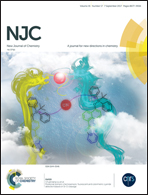Synthesis, the electronic properties and efficient photoinduced electron transfer of new pyrrolidine[60]fullerene- and isoxazoline[60]fullerene-BODIPY dyads: nitrile oxide cycloaddition under mild conditions using PIFA†
Abstract
Two new BODIPY-C60 dyads, with a pyrrolidine linker (BDP-Pyr) and an isoxazoline linker (BDP-Is) between the two electroactive units, have been synthesized and characterized. Their photophysical and electrochemical properties have been studied in solution by comparing with the reference compounds BDP and [60]fullerene. Both BODIPY-C60 derivatives strongly absorb visible light and by photoexcitation at the BDP unit, these dyads undergo photoinduced electron transfer affording the corresponding charge-separated species. Based on their redox potentials, also the direction of the charge transfer is revealed and a comparison between the dyads with respect to C60 suggested that the new BDP-Is derivative showed a better electron affinity than BDP-Pyr and C60. In addition, the experimental studies were complemented by a theoretical analysis based on semiempirical computations which allowed confirming of the charge transfer mechanism from the BDP core to the C60 cages.
![Graphical abstract: Synthesis, the electronic properties and efficient photoinduced electron transfer of new pyrrolidine[60]fullerene- and isoxazoline[60]fullerene-BODIPY dyads: nitrile oxide cycloaddition under mild conditions using PIFA](/en/Image/Get?imageInfo.ImageType=GA&imageInfo.ImageIdentifier.ManuscriptID=C7NJ02057K&imageInfo.ImageIdentifier.Year=2017)


 Please wait while we load your content...
Please wait while we load your content...